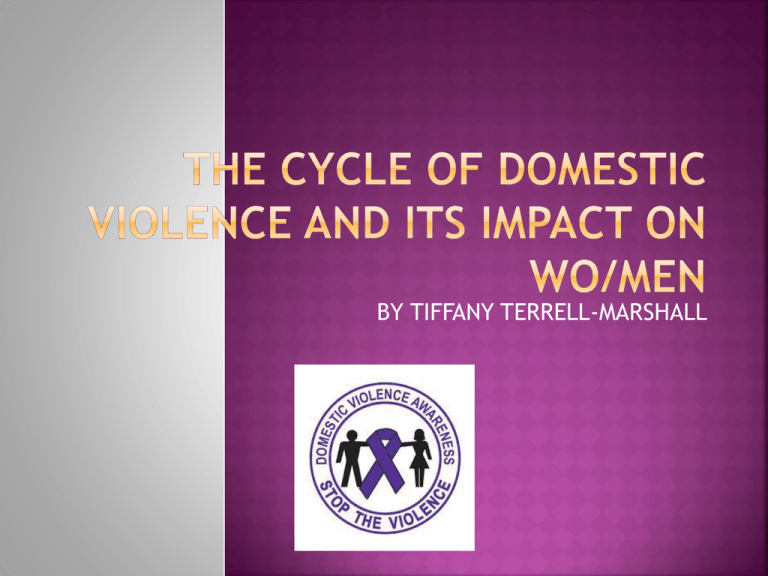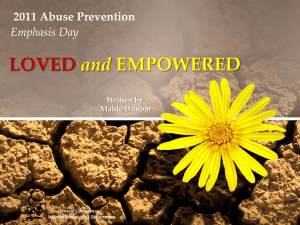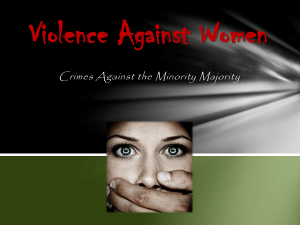
BY TIFFANY TERRELL-MARSHALL
Domestic
violence and are behaviors used by one
person in a relationship to control the other.
Partners may be married or not married;
heterosexual, gay, or lesbian; living together,
separated or dating.
Violence can be criminal and includes physical
assault (hitting, pushing, shoving, etc.), sexual
abuse (unwanted or forced sexual activity), and
stalking. Although emotional, psychological and
financial abuse are not criminal behaviors, they are
forms of abuse and can lead to criminal violence.
Domestic
violence is also referred to as
Intimate Partner Violence
1871 Alabama becomes the first state to repeal the legal right of a
husband to beat his wife.
1967 One of the first domestic violence shelters opens in Maine.
1972 The first emergency rape crisis hotline opens in Washington,
DC
1975 Pennsylvania creates the first state coalition against sexual
assault (Pennsylvania Coalition Against Rape). A year later,
Pennsylvania also becomes home to the first state coalition against
domestic violence (Pennsylvania Coalition Against Domestic
Violence) and to provide orders of protection for battered women.
1976 La Casa de Las Madres in San Francisco, California is
opened. This was the first battered women’s shelter established by
women of color.
1984
The Duluth Project ("Power and
Control" Wheel) is formed and pioneers the
first coordinated criminal justice response
model to domestic violence.
1984 The U.S. Department of Justice
establishes the Task Force on Family
Violence and submits the first-ever report
that examines the scope and impact of
domestic violence in America.
1985
U.S. Surgeon General C. Everett Koop
identifies domestic violence as a public
health issue that cannot be dealt by the
police alone.
1988 Congress amends the Victims of
Crime Act, requiring state victim
compensation programs to make awards to
victims of domestic violence.
1990 U.S. Senator Biden introduces the
first Violence Against Women Act.
September
13, 1994 Violence Against
Women Act is signed into law as part of the
Violent Crime Control and Law
Enforcement Act of 1994.
1995 U.S. President Bill Clinton appoints
Bonnie Campbell to head the Department of
Justice's Violence Against Women Policy
Office (VAWO).
1996 The National Domestic Violence
Hotline begins operating and receives its
first call on February 21st.
1996
The National Domestic Violence
Hotline begins operating and receives its
first call on February 21st.
2000 President Clinton signs the Violence
Against Women Act of 2000 into law.
2006 U.S. President George W. Bush signs the
Violence Against Women Act of 2005 into law.
2009 U.S. President Barack Obama becomes
first president to declare April as Sexual
Assault Awareness Month
In
a survey taken by the Centers for Disease
Control (CDC) in 2010, it was found that 40%
of the victims of severe, physical domestic
violence are men.
Despite many findings that show almost
equal amounts of abuse perpetrated against
men and women, the media and government
focus the most attention on the female
victims of domestic violence.
More men than women were victims of
intimate partner physical violence
within the past year, according to a
national study funded by the Centers
for Disease Control and U.S.
Department of Justice.
According to the National Intimate
Partner and Sexual Violence Survey
(hereinafter NISVS) released in
December, 2011, within the last 12
months an estimated 5,365,000 men
and 4,741,000 women were victims of
intimate partner physical violence.
(Black, M.C. et al., 2011, Tables 4.1
and 4.2) 1 This finding contrasts to the
earlier National Violence Against
Women Survey (Tjaden, P. G., &
Thoennes, N., 2000)(hereinafter
NVAWS), which estimated that 1.2
million women and 835,000 men were
victims of intimate partner physical
violence in the preceding 12 months
There
is a significant
difference between the
NVAWS and NISVS
surveys: in the number
of victims of physical
violence
National Intimate
Partner and Sexual
Violence Survey
estimated 4,741,000
women/ 5,365,000 men
Vs National Violence
Against Women Survey
1.2 million
women/835,000 men
Although
there has been an increase in the
number of fatal domestic violence incidents
against women, men are more likely to be
victims of attacks with a deadly weapon.
According to one study, 63% of males as
opposed to 15% of females had a deadly
weapon used against them in a fight with an
intimate partner.
1 in 4 women (24.3%) and 1 in 7 men (13.8%)
aged 18 and older in the United States have been
the victim of severe physical violence by an
intimate partner in their lifetime (Black et al.,
2011).
Nearly, 15% of women (14.8%) and 4% of men
have been injured as a result of intimate partner
violence (IPV) that included rape, physical
violence, and/or stalking by an intimate partner
in their lifetime (Black et al., 2011). In 2010,
241 males and 1095 females were murdered by
an intimate partner (U.S. Department of Justice,
FBI, 2011).
In
Texas, 39% of all women murdered in 2011
were victims of intimate partner violence.
The Texas Council on Family Violence (TCFV)
released a report on October 31, 2013 that
shows an increase in the number of women
killed in domestic violence murders in Texas
by their husband, ex-husband, intimate
partner, boyfriend or ex-boyfriend. The
report reveals 114 women were killed in
domestic violence murders in 2012. 102
women were killed in 2011.
The 2012 fatalities reflect that victims' ages ranged from 15 to 84.
Three women were under the age of 20; a 22-year-old boyfriend killed a 15year-old minor by strangling her to death in a hotel room.
The eldest (84 years old) victim's husband shot and killed her.
Victims age 30-39 represent the most prevalent age group; followed by
victims' age 20-29, and then by victims age 40-49.
These trends have remained consistent for the last two years. Unlike 2011,
which saw no fatalities for women age 60-69, four women in this age group
were murdered in 2012.
In line with the previous years, Harris County, which includes the city of
Houston, experienced the highest number of deaths (30). Next in descending
order were Dallas County (9), which includes the city of Dallas, Tarrant County
(6), which includes Fort Worth and Arlington and Bexar County (5), which
includes the city of San Antonio. El Paso County experienced four deaths in
2012, an increase from previous years. Significantly, Hidalgo County
experienced four fatalities; Hidalgo County includes the cities of Hidalgo and
Alton and this county has a significantly lower population than the top five or
indeed other counties with fewer fatalities. Travis County (3), which includes
the city of Austin is the fifth largest county in the state and had three
domestic violence murders.
Some key statistics include:
• The victim's ages ranged from age 15 to 84
• Harris County had the highest number of deaths
(30)
• 74% of the women were killed at home
• 60% were shot
• 17% were stabbed
• 11% were strangled
• 21 women had taken steps to leave
• 20 homicides took place within one to two days
of a national holiday
• 15 bystanders or witnesses killed
• 4 bodies burned
Physical abuse is the use of physical force against another in a way that injures that
person or puts the
victim at risk of being injured. Physical abuse ranges from physical restraint to murder and may
include
pushing, throwing, tripping, slapping, hitting, kicking, punching, grabbing, chocking, shaking, etc.
Emotional/Psychological abuse is any use of words, tone, action or lack of action meant to
control,
hurt or demean another person. Emotional abuse typically includes ridicule, intimidation, or
coercion.
Verbal abuse is included in this category.
Sexual abuse is any forced or coerced sexual act or behavior motivated to acquire power
and control
over the partner. It includes forced sexual contact and contact that demeans, humiliates or
instigates
feelings of shame or vulnerability, particularly in regards to the body, sexual performance or
sexuality.
Financial abuse is the use or misuse of the financial or monetary resources of the partner
or of the
partnership without the partner’s freely given consent. It can include preventing the partner from
working
Verbal Abuse:
Name-calling
Put downs
Yelling
Use of profanity
Unfounded accusations
Cruel and hurtful remarks
Degrading the victim in public
Diminishing accomplishments
Flying into rages
Emotional Abuse:
Isolation
Ignoring
Controlling finances or employment
Lack of trust/Suspicion
Following or stalking the victim
Criticizing
Threats of suicide
Physical Abuse:
Choking/Strangulation
Holding the victim down against their
will
Throwing or breaking objects
Pushing
Shoving
Slapping
Biting
Punching
Kicking
Using a weapon
Murder
Sexual Abuse:
Rape
Forcing unwanted sexual acts
Use of weapons during sex
Forced sex involving multiple partners
Inflicts pain during sex
Anxiety
Depression
Symptoms of post-traumatic
stress disorder (PTSD)
Antisocial behavior
Suicidal behavior in females
Low self-esteem
Inability to trust others,
especially in intimate
relationships
Fear of intimacy
Emotional detachment
Sleep disturbances
Flashbacks
Replaying assault in the mind
According to the National
Center
for Victims of Crime: men
experience many of the same
psychological reactions to
violence as women. These
include:
Guilt, shame, and
humiliation
Anger and anxiety
Depression
Withdrawal from
relationships
Before beginning therapy you should assess your client’s level of safety: you can use you own version of a safety
scale (rating 1-10) (10) being the client does not feel in danger at all at home and or out in public places, (I)
being the client is in extreme fear of being abused by their intimate partner and or have recently experienced
abuse by their intimate partner. Your initial session may involve safety planning and providing referrals, such as
shelters.
Before you start counseling you need to take some time to understand yourself and your own prejudices.
Everyone has prejudices and biases that they must address in order to be a neutral and supportive counselor.
Some of the possible issues that you will face as a counselor are…
• Domestic Violence
• Incest
• Child Abuse
• STDs, HIV/AIDS
• Birth-control, condoms
• Drug/Alcohol use/abuse
• Pre-marital sex
• Sexual Assault
• Rape
• Sexual Harassment
Safety Planning
Memorize important phone numbers of people to call in emergency
If your children are old enough, teach them important phone numbers, including when to dial 911
Keep information about domestic violence in a safe place, where your abuser won’t find it, but where you can
get it when you need to review it
Keep change for pay phones with you at all times
If you can, open your own bank account
Stay in touch with friends. Get to know your neighbors.
Don’t cut yourself off from people, even if you feel like
you want to be alone
Rehearse your escape plan until you know it by heart
Leave a set of car keys, extra money, change of clothes
and copies of important documents with a trusted friend or
relative: your own and your children’s birth certificates,
children’s school and medical records, bank books, welfare
identification, passport/green card, immigration papers,
social security card, lease agreements or mortgage
payment books, insurance papers, important addresses and
telephone numbers
Devise a code word or sign (such as turning on a particular
light) to use with your children, family, friends and
neighbors when you need them to call 911 for help from
the police.
Figure
taken from MenWeb: CDC/DOJ Survey
Men more often victims of intimate partner
violence.
http://www.batteredmen.com/NISVS.htm
Philip Cook,”The Truth About Domestic
Violence”. From the book Everything You
Know is Wrong (Russ Kick, 2002). Published
by The Disinformation Company.
Domestic Abuse Hotline for Men and Women.
http://dahmw.org/
Black,
M.C. 2011. Intimate partner violence
and adverse health consequences:
implications for clinicians. Am J Lifestyle
Med 5(5):428-439.
Black, M.C., Basile, K.C., Breiding, M.J.,
Smith, S.G., Walters, M.L., Merrick, M.T.,
Chen, J., & Stevens, M.R. (2011). The
National Intimate Partner and Sexual
Violence Survey (NISVS): 2010 Summary
Report. Atlanta, GA: National Center for
Injury Prevention and Control, Centers for
Disease Control and Prevention.
www.ncadv.org/files/MaleVictims.pdf
Mo-Yee Lee, PhD, 2007.Discovering Strengths
and Competencies in Female Domestic
Violence Survivors: An Application of Roberts'
Continuum of the Duration and Severity of
Woman Battering. Brief Treat Crisis Interv
Oxford University Press.
http://www.hotpeachpages.net/camerica/b
elize/DomesticViolenceTrainingManual.pdf
http://www.genesisshelter.org/
National
Domestic Violence Hotline at 1-800799-SAFE
National Sexual Assault Hotline at 1-800-656HOPE
National Child Abuse Hotline at 1-800-4-ACHILD










